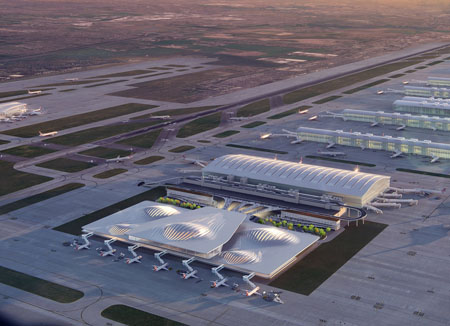Government offers air quality assurance over Heathrow expansion
The Department for Transport (DfT) has declared that a third runway at Heathrow ‘is deliverable within air quality limits’ — after backing the development of additional capacity at the airport.
Transport Secretary Chris Grayling this morning (25 October) announced that the government has favoured development at Heathrow in West London, rather than opting for plans to build a second runway at Gatwick in West Sussex.
The scheme will now be taken forward for consultation in the form of a draft ‘National policy statement’.
Government backing for a third runway at Heathrow had been widely expected — after a report issued by the Airports Commission last summer stated that the development ‘presented the strongest case’ for increasing the UK’s airport capacity.
However, the Commission claimed that this should only go ahead if there is a ‘binding commitment’ that the UK’s compliance with air quality limits will not be affected (see AirQualityNews.com story).
Assessment
Announcing the decision in the House of Commons today, Mr Grayling said that the government had carried out detailed assessment of the environmental impact of the Heathrow proposals, which he said “confirms that a new runway is deliverable within air quality limits.”
He said: “Air quality is a significant international health issue which this government takes very seriously. That’s why we undertook further work which confirms the commission’s original conclusion on air quality that a new runway at Heathrow is deliverable within air quality limits and we remain committed to ensuring this remains the case.
“The airport has already committed to industry leading measures to mitigate air quality impacts.
“Furthermore, this government will only grant development consent if we remain satisfied that a new runway will not impact on the UK’s compliance with its air quality obligations.”
Commenting on the announcement, a Heathrow spokesperson said: “We welcome the news that Heathrow is Government’s preferred site for a new runway and look forward to hearing the full details later from the Transport Secretary.”
Impacts
In the wake of the decision, DfT has also released a fact sheet detailing some of the potential environmental impacts from the development, which claims: “The Government believes that with a range of policy measures and environmental mitigations, expansion at Heathrow can be delivered within legal air quality requirements.”
On potential measures being put in place to mitigate the effect of the new runway, it adds: “Heathrow’s scheme includes plans for improved public transport links and for an ultra-low emissions zone for airport vehicles by 2025. It also has a target of at least 50% of passenger journeys to the airport being made on public transport by 2030.”
Despite the assurances from DfT over measures to mitigate the air quality impact of the development, the decision has been criticised by a number of environmental campaign groups as well as the Mayor of London, Sadiq Khan, who said the development would be ‘devastating’ for air quality in the capital.
Mayor
Reacting to the decision today, the Mayor said: “A new runway at Heathrow will be devastating for air quality across London — air pollution around the airport is already above legal levels of NO2.”
Client Earth, the legal firm behind the challenge against the government’s plans to tackle air pollution has also criticised the decision.
The firm’s chief executive James Thornton, said: “Firstly, even without expansion, the area around Heathrow will continue to be in breach of legal air pollution limits until 2025 at least, under the government’s current projections.”
However, the move has been welcomed by the Institution of Civil Engineers (ICE), which claimed the move would ‘provide a huge boost to UK Plc at a time of uncertainty.
Nick Baveystock, ICE’s director general, said: “If the UK is to have a 21st Century transport network that enables balanced economic growth, thriving communities and health and wellbeing, the decision on aviation needs to address the connectivity throughout the UK plus air quality and noise issues. The benefits of such transformational projects will only be realised with this integrated approach.”

















